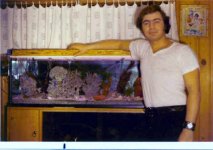- Location
- Baiting Hollow Long Island NY
"Breeding Condition" for fish is a term that used to be used a lot but I don't hear it any more. It means that the fish are in such a good condition that they are capable of breeding. In a tank it is not easy to keep fish in this condition. Almost no fish in a store will be in this condition which is also the reason that you see so many animals for sale with ich. Fish in breeding condition almost never get ich or anything else (personal experience, don't beat me up).
Fish in breeding condition have scales that look like velvet and shiny, aware eyes. They rarely hide (except for some species) and are constantly cleaning nest sites (unless they are egg scatters) and chasing other fish away. They will also fight rival males.
These nuances are not always easy to see and may take years to fully understand.
If you do much diving you can immediately notice the differences in behavior in wild fish.
Fish are not evenly scattered in all tropical seas for a few reasons, one is obviousely that they can't get there but the other is water conditions like temperature, depth, food, salinity etc.
We can't do much for depth but we have control of the other variables.
Food is a big one that is vastly misunderstood. We can get most fish to eat almost anything. My moorish Idol would eat cardboard if I put some clam juice on it. Too many times we feel that if the fish is eating we are doing our jobs. We are not. Many people feed fish fillets, lettuce, crabmeat, shrimpmeat, beef heart, brine shrimp, and flakes. With the exception of brine shrimp and flakes, these foods are all fine for people but maybe not the best for fish. They will keep fish alive but will not get them into the best condition they can be in or breeding condition. Fish in the sea eat mostly fish. Whole fish, not fillets. Most of the nutrition in a fish is condensed in the organs. Almost all of the vitamin "A" is in the liver and all of the calcium is in the bones. They also eat whole shrimp, shell and all along with whole crab.
They do not eat beef heart (piranna maybe). Beef should never be fed to fish because the fats in beef need a higher temperature to be liquified making it hard to digest in a fish. Fish have no fat, just oils.
The best diet for salt water fish is live salt water fish. I know this is tough to get and almost no one has access to this food especially in the winter so it is important to get these missing nutrients into the fish. Vitamin "A" is especially lacking in aquarium fish and is a large part of their natural diet. A fish liver is about 25% vitamin "A".
I get tiny dried salt water fish from an Asian market and sometimes use these but they are like wood and need a lot of time to soften up.
I feed live California black worms every day and can get almost any fish into breeding condition in a couple of weeks with this food. I understand that they are not available in all parts of the country which is a shame since they are very common in NY. I have been feeding them to my fish since the early sixtees.
I also soak flake food or pellets in Cod Liver OIl which is essencially vitamin "A" and feed this about once a week.
For larger fish like groopers, morays, lions, and frog fish I sometimes inject cod liver oil into guppies to feed to these fish. I know that is a pain, but if you have a fish that only eats live fish and all you can get is guppies, it works.
Live newborn brine shrimp is an excellent food for smaller fish and sometimes the only food some fish will eat. I hatch these every day and fill my reef with them.
I know these methods work, I have not lost a fish to a disease in over twenty years and if there is no accident, they die of old age which may be 20 years in many fish.
Anybody have and opinions or comments?
Fish in breeding condition have scales that look like velvet and shiny, aware eyes. They rarely hide (except for some species) and are constantly cleaning nest sites (unless they are egg scatters) and chasing other fish away. They will also fight rival males.
These nuances are not always easy to see and may take years to fully understand.
If you do much diving you can immediately notice the differences in behavior in wild fish.
Fish are not evenly scattered in all tropical seas for a few reasons, one is obviousely that they can't get there but the other is water conditions like temperature, depth, food, salinity etc.
We can't do much for depth but we have control of the other variables.
Food is a big one that is vastly misunderstood. We can get most fish to eat almost anything. My moorish Idol would eat cardboard if I put some clam juice on it. Too many times we feel that if the fish is eating we are doing our jobs. We are not. Many people feed fish fillets, lettuce, crabmeat, shrimpmeat, beef heart, brine shrimp, and flakes. With the exception of brine shrimp and flakes, these foods are all fine for people but maybe not the best for fish. They will keep fish alive but will not get them into the best condition they can be in or breeding condition. Fish in the sea eat mostly fish. Whole fish, not fillets. Most of the nutrition in a fish is condensed in the organs. Almost all of the vitamin "A" is in the liver and all of the calcium is in the bones. They also eat whole shrimp, shell and all along with whole crab.
They do not eat beef heart (piranna maybe). Beef should never be fed to fish because the fats in beef need a higher temperature to be liquified making it hard to digest in a fish. Fish have no fat, just oils.
The best diet for salt water fish is live salt water fish. I know this is tough to get and almost no one has access to this food especially in the winter so it is important to get these missing nutrients into the fish. Vitamin "A" is especially lacking in aquarium fish and is a large part of their natural diet. A fish liver is about 25% vitamin "A".
I get tiny dried salt water fish from an Asian market and sometimes use these but they are like wood and need a lot of time to soften up.
I feed live California black worms every day and can get almost any fish into breeding condition in a couple of weeks with this food. I understand that they are not available in all parts of the country which is a shame since they are very common in NY. I have been feeding them to my fish since the early sixtees.
I also soak flake food or pellets in Cod Liver OIl which is essencially vitamin "A" and feed this about once a week.
For larger fish like groopers, morays, lions, and frog fish I sometimes inject cod liver oil into guppies to feed to these fish. I know that is a pain, but if you have a fish that only eats live fish and all you can get is guppies, it works.
Live newborn brine shrimp is an excellent food for smaller fish and sometimes the only food some fish will eat. I hatch these every day and fill my reef with them.
I know these methods work, I have not lost a fish to a disease in over twenty years and if there is no accident, they die of old age which may be 20 years in many fish.
Anybody have and opinions or comments?







